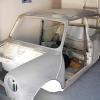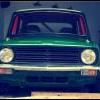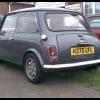Crank Rotation?
#1

Posted 10 October 2012 - 12:24 PM
#2

Posted 10 October 2012 - 12:48 PM
hope that helps
Trac
Edited by tractor, 10 October 2012 - 12:49 PM.
#3

Posted 10 October 2012 - 12:56 PM
#4

Posted 10 October 2012 - 01:01 PM
Prior to proceeding, remove the distributor cap and have an assistant turn the engine over on the starter. Observe
and record the normal direction of rotation for 1) the engine, and 2) the rotor in the distributor. The A-series and Bseries
engines have clockwise (CW) crank rotation when looking at the front (radiator fan end) of the engine and
their distributor rotors turn counterclockwise (CCW) when observed looking straight down on them. On A- and Bseries
engines #1 cylinder is closest to the radiator fan.
#5

Posted 10 October 2012 - 01:59 PM
In some ways it would be better for the Mini engine to run the other way, as it would allow the idler gear to be eliminated.
#6

Posted 10 October 2012 - 02:54 PM
In some ways it would be better for the Mini engine to run the other way, as it would allow the idler gear to be eliminated.
Didn't one of the mini prototypes have the engine the other way around in the engine bay, with the carb and exhaust manifold facing the front?
#7

Posted 10 October 2012 - 03:20 PM
#8

Posted 10 October 2012 - 03:57 PM
#9

Posted 10 October 2012 - 04:24 PM
#10

Posted 10 October 2012 - 06:11 PM
After working on a new-build 1275GT engine the other day I went to the gliding club and did some work on our winch engine which is an 11.6 litre DAF diesel engine. What a contrast.
#11

Posted 10 October 2012 - 06:30 PM
#12

Posted 10 October 2012 - 06:31 PM
The only engine I've ever heard of turning anti-clockwise was the AEC Diesel engine fitted to the 1935 Q-Type bus chassis from AEC. Now, you all really needed to know that I'm sure
damn you! was quit exited to share my knowledge of strange engines with people when i saw this topic. but no, you had to go ruin it ;)
#13

Posted 10 October 2012 - 08:16 PM
#14

Posted 10 October 2012 - 11:41 PM
The engine would have been a single cylinder 4 stroke diesel, most likely a Petter, and was on either the circular saw or the dumper, I can't remember which. There were Listers on the small tower crane (3 cylinders) and both concrete mixers (2 cylinders), and they ran clockwise. The three cylinder was a pig to start, because there was nowhere proper to stand to get a good swing at it, the crankshaft being about 8 feet off the ground, a badly designed aftermarket conversion to an electric crane. And, it was well-nigh impossible to get a free hand to pull the decompressor, above and behind the starting handle, while swinging it. We used to wedge a length of 6*2 timber under the slewing ring for something to stand on, but if the thing had swung to an unsuitable angle during the night due to wind, that was not always possible. I fell off a few times, but the ultimate horror, the handle failing to disengage, never happened to me.
The concrete vibrators used to be petrol, but they went over to diesel, and for some reason no-one but me could start them on the first pull of the rope. It is a big advantage to read the instructions, which described how to pull out a priming plug, fill the small hole with engine oil, push the plug back in, rotate the flywheel with decompressor engaged to TDC, and listen for the injector to squeak. Back and forwards through TDC till injector had squeaked 3 times, decompressor off, apply rope and pull. They fired up first time, every time, even in the middle of winter. Simple, but I guess no-one else bothered to read the instructions clearly printed on a large label. I did see someone trying to start one backwards once, but as he had not primed it, it never fired, which is just as well, as the rope might not have disengaged from the angled notch in the rim of the flywheel pulley, and his hand could have been wound in.
Some things you never forget. I had a bit of fun about 25 years later, having just arrived in Glasgow by train. I went round to my old man's latest and last building site, where someone was trying unsuccessfully to start one of these engines. He was distracted by something else momentarily, so I primed it with some oil from the dipstick, ensured that the injector squeaked the obligatory three times, put the rope on and pulled. You should have seen the look on his face when he noticed that I had the thing running. The moral of the tale is ALWAYS READ THE INSTRUCTIONS, which is good advice for everyone on this forum too.
If the timing is not too extreme, as it will not be in a low speed diesel, the engine does not care much which port is inlet or exhaust, but the air filter definitely does not like hot, high pressure exhaust gas, when it is supposed to experience only fresh atmospheric air.
I assume that due to health and safety we no longer have engines like those with non self-disengaging starting handles or rope starts on open pulleys. Maybe safer, but far less fun.
#15

Posted 11 October 2012 - 03:52 AM
The idea being that it shifts the power in a downwards force, thus increasing grip.
1 user(s) are reading this topic
0 members, 1 guests, 0 anonymous users



















